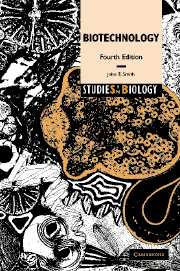Book contents
- Frontmatter
- Contents
- Preface
- 1 The nature of biotechnology
- 2 Substrates for biotechnology
- 3 Genetics and biotechnology
- 4 Bioprocess/fermentation technology
- 5 Enzyme technology
- 6 Biological fuel generation
- 7 Single cell protein (SCP)
- 8 Biotechnology and medicine
- 9 Environmental biotechnology
- 10 Biotechnology in the agricultural and forestry industries
- 11 Food and beverage biotechnology
- 12 Protection of biotechnological inventions
- 13 Safety in biotechnology
- 14 Public perception of biotechnology: genetic engineering – safety, social, moral and ethical considerations
- 15 Looking to the future
- Glossary
- Further reading
- Index
1 - The nature of biotechnology
Published online by Cambridge University Press: 05 June 2012
- Frontmatter
- Contents
- Preface
- 1 The nature of biotechnology
- 2 Substrates for biotechnology
- 3 Genetics and biotechnology
- 4 Bioprocess/fermentation technology
- 5 Enzyme technology
- 6 Biological fuel generation
- 7 Single cell protein (SCP)
- 8 Biotechnology and medicine
- 9 Environmental biotechnology
- 10 Biotechnology in the agricultural and forestry industries
- 11 Food and beverage biotechnology
- 12 Protection of biotechnological inventions
- 13 Safety in biotechnology
- 14 Public perception of biotechnology: genetic engineering – safety, social, moral and ethical considerations
- 15 Looking to the future
- Glossary
- Further reading
- Index
Summary
Introduction
Major events in human history have, to a large extent, been driven by technology. Improved awareness of agriculture and metalworking brought mankind out of the Stone Age, while in the nineteenth century, the Industrial Revolution created a multitude of machinery together with ever-increasingly larger cities. The twentieth century was undoubtedly the age of chemistry and physics, spawning huge industrial activities such as petrochemicals, pharmaceuticals, fertilisers, the atom bomb, transmitters, the laser and microchips. However, there can be little doubt that the huge understanding of the fundamentals of life processes achieved in the latter part of the twentieth century will ensure that the twenty-first century will be dominated by biology and the associated technologies.
Societal changes are increasingly driven by science and technology. Currently, the impact of new biological developments must be absorbed not just by a minority (the scientists) but also by large numbers (the general public). If this does not happen the majority will be alienated. It is increasingly important to ensure a broad understanding of what bioscience and its related technologies will involve, and especially what the consequences will be of accepting or rejecting the new technical innovations.
The following chapters will examine how the new biotechnologists are: developing new therapies and cures for many human and animal diseases; designing diagnostic tests for increasing disease prevention and pollution control; improving many aspects of plant and animal agriculture; cleaning and improving the environment; and designing clean industrial manufacturing processes.
- Type
- Chapter
- Information
- Biotechnology , pp. 1 - 20Publisher: Cambridge University PressPrint publication year: 2004

